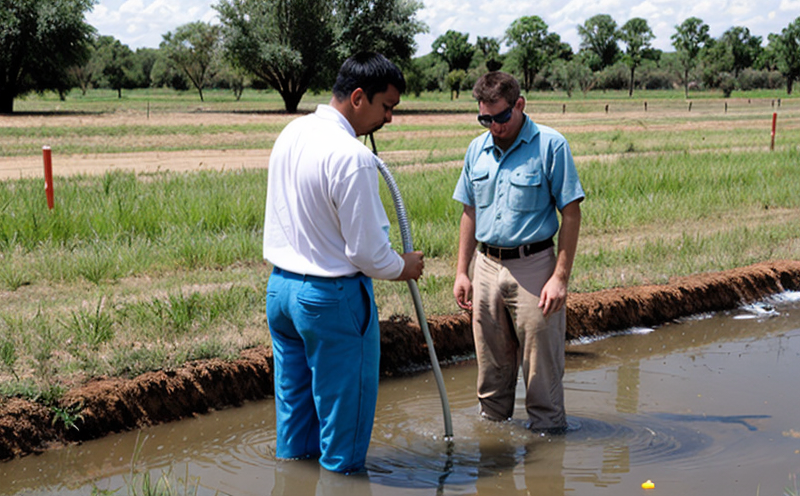ASTM D5465 Algal Growth Potential Test in Groundwater
The ASTM D5465 algal growth potential (GPP) test is a critical tool used to assess the biodegradation capacity of groundwater, particularly when assessing compliance with environmental regulations and ensuring water quality standards are met. This test evaluates the ability of algae to grow under specific conditions, which can indicate the presence of organic compounds that could be bioavailable for degradation.
The GPP test is performed by inoculating a known volume of groundwater into a closed system containing algal cells. The system is then incubated under controlled environmental conditions, and the rate at which algae consume carbon dioxide (CO2) is measured as an indicator of the potential for biodegradation within that water sample. This information helps to determine if the organic matter in the groundwater can be effectively broken down by natural processes.
Understanding GPP is essential for several reasons:
- To evaluate the intrinsic biodegradability of contaminants in groundwater, which aids in determining potential risks and appropriate remediation strategies.
- To support decision-making regarding wastewater treatment plant performance and discharge permits.
- To assist in the assessment of site-specific contamination levels by comparing GPP values with established benchmarks for pristine waters.
The ASTM D5465 test is particularly valuable in sectors such as environmental consulting, industrial water management, and regulatory compliance. It helps stakeholders make informed decisions about groundwater quality, ensuring that environmental impacts are minimized while meeting legal requirements.
For researchers involved in environmental science or chemical engineering, this test can provide insights into the microbial community dynamics within groundwaters, contributing to a deeper understanding of ecosystem health and potential remediation strategies.
The algal growth potential test is often part of a broader suite of analyses aimed at assessing groundwater quality. By integrating results from various tests, including nutrient analysis (e.g., nitrate and phosphate levels), toxicity testing using organisms like Daphnia magna, and chemical analysis for specific contaminants, comprehensive evaluations can be conducted.
The ASTM standard ensures that the GPP test is consistently applied across different laboratories, providing reliable data that can be used to make informed decisions. This consistency is crucial in ensuring that results are comparable and actionable.
| Standard | Description |
|---|---|
| ASTM D5465-18 | This standard describes the procedures for determining algal growth potential in groundwater samples. It specifies the method of inoculating algae into a closed system, incubating conditions, and measuring CO2 consumption rates. |
The ASTM D5465 GPP test is widely recognized as an important tool for assessing the biodegradability of organic compounds in groundwater. By providing a quantitative measure of algal growth under controlled conditions, this test helps to assess the potential for natural degradation processes within contaminated waters. Understanding these parameters is essential for effective environmental management and regulatory compliance.
Why It Matters
The ASTM D5465 GPP test holds significant importance in several contexts:
Regulatory Compliance: Many regions have stringent regulations governing the quality of groundwater used for drinking water supplies or industrial processes. The GPP test is a key component in ensuring that these waters meet legal standards, particularly regarding biodegradability.
Risk Assessment: By evaluating the potential for natural degradation within contaminated waters, stakeholders can better assess risks associated with groundwater contamination. This information is crucial for developing appropriate remediation strategies and predicting long-term environmental impacts.
Research and Development: For researchers in environmental science or chemical engineering, GPP testing offers valuable data on microbial community dynamics within groundwaters. This insight contributes to a deeper understanding of ecosystem health and potential remediation approaches.
Water Treatment Optimization: In wastewater treatment facilities, monitoring the biodegradability of organic compounds using GPP tests helps optimize treatment processes, ensuring that effluents meet discharge permit requirements.
The GPP test is not just a compliance tool; it also provides valuable insights into the natural processes governing groundwater quality. By integrating results from various analyses, stakeholders can make more informed decisions about water management and environmental stewardship.
Competitive Advantage and Market Impact
The ASTM D5465 GPP test offers several competitive advantages:
- Innovation in Environmental Management: By providing reliable data on algal growth potential, this test enables stakeholders to innovate in environmental management strategies. It supports the development of more effective remediation techniques and water treatment processes.
- Enhanced Reputation: Companies that invest in GPP testing demonstrate a commitment to sustainable practices and regulatory compliance. This can enhance their reputation among customers, partners, and regulators.
- Cost Efficiency: Early identification of contamination risks through GPP testing allows for targeted remediation efforts, reducing overall costs associated with extended cleanup processes.
- Market Differentiation: Offering advanced GPP testing services can differentiate a company from its competitors in the environmental sector. This differentiation is particularly valuable for firms operating within regions with strict environmental regulations.
The impact of GPP testing extends beyond individual organizations; it contributes to broader market trends and industry standards. As more companies adopt this technology, there is an increasing demand for reliable testing services, driving innovation in the field of groundwater analysis. This trend is expected to continue as regulatory pressures increase and public awareness of environmental issues grows.





